Model-based Enterprise Market Size
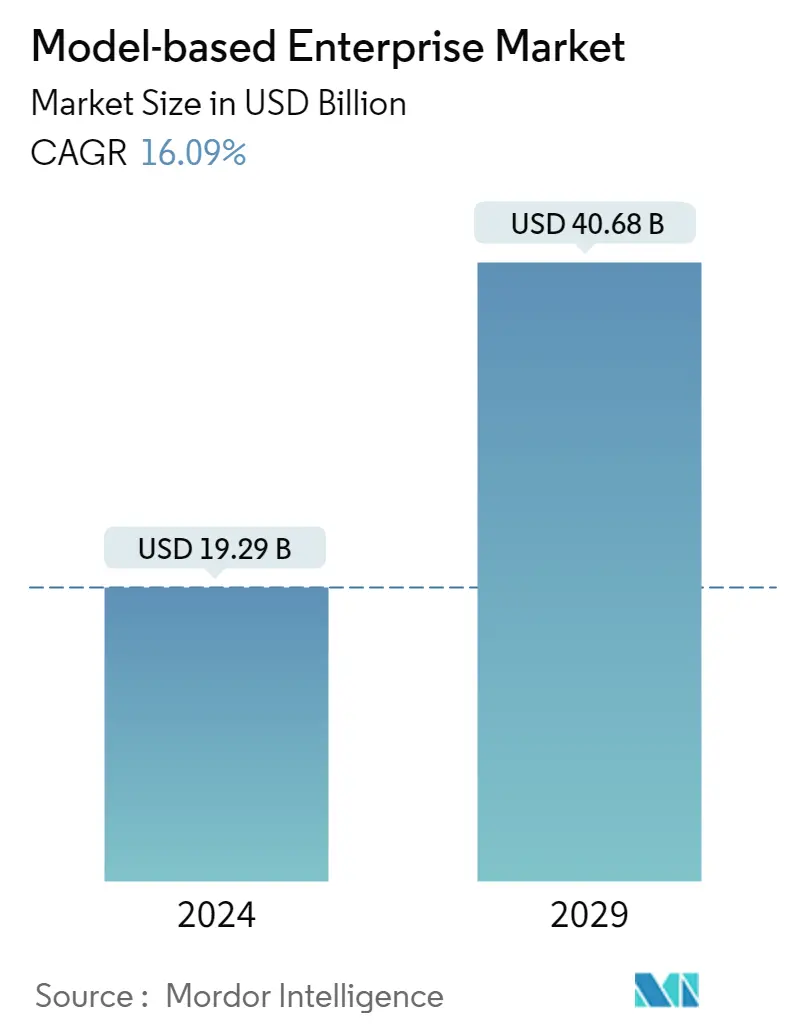
| Study Period | 2018 - 2028 |
| Market Size (2023) | USD 16.62 Billion |
| Market Size (2028) | USD 35.04 Billion |
| CAGR (2023 - 2028) | 16.09 % |
| Fastest Growing Market | Asia-Pacific |
| Largest Market | North America |
Major Players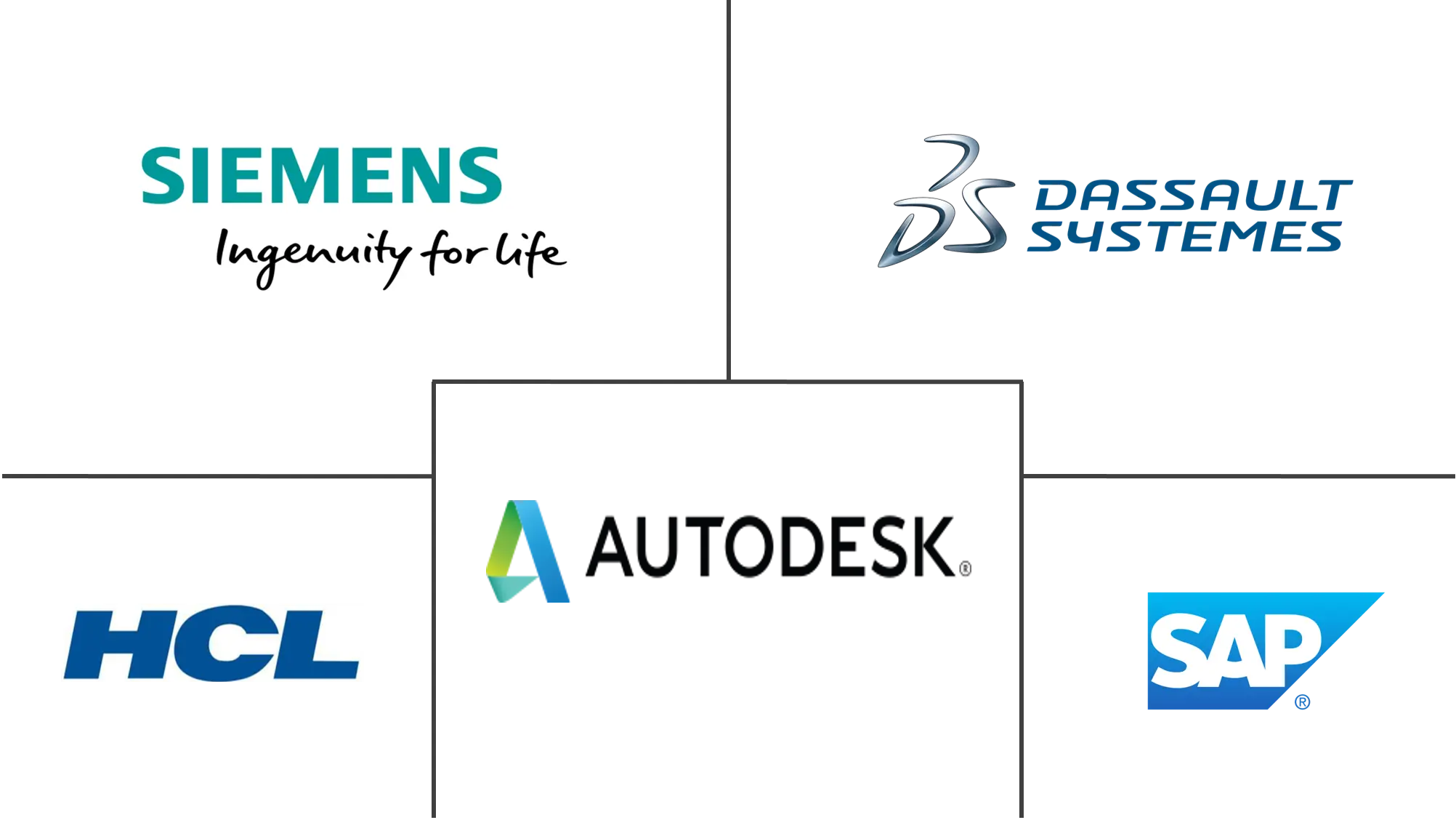
*Disclaimer: Major Players sorted in no particular order |
Need a report that reflects how COVID-19 has impacted this market and its growth?
Model-based Enterprise Market Analysis
The Model-based Enterprise Market size is expected to grow from USD 16.62 billion in 2023 to USD 35.04 billion by 2028, at a CAGR of 16.09% during the forecast period (2023-2028).
- The increasing adoption of 3D technology across multiple industry verticals for catering to the growing demand for emerging applications, ranging from shape analysis, 3D modeling, and many more, has given rise to the development and adoption of model-based enterprise solutions that can gauge product shapes in real-time.
- The technology offers many opportunities in the design and production processes and performance of novel architectural forms, construction systems, and many more. It is an innovative, faster, and more agile product development and production method.
- Digital technologies are being adopted across various manufacturing industries due to the rapidly evolving capabilities of the software, further boosting the market growth.
- The industries are witnessing increased adoption of reverse engineering for its rapid prototyping abilities and accuracy for producing new parts. Reverse engineering requires a strong and robust image acquisition system that can acquire data with high accuracy. The deployment of 3D technology and solutions could enable manufacturers to achieve such objectives, thus, boosting market growth.
- The objective for migrating from a traditional on-premise enterprise data warehouse to the cloud is cost savings. The total cost includes owning or licensing data center equipment and third-party service costs, maintenance and management, training, and policy. These indirect costs can account for a large amount of the price of operating on-premise data centers.
- Further, space, construction, energy, air conditioning, hardware procurement, operating systems, networking, physical security, and more are required to maintain on-premise computing infrastructure. Instead, model-based enterprise vendors are outsourcing these expenses to a cloud service provider and saving costs. Many companies that have data infrastructure on their premises are concerned about security. Having a data center within the perimeter gives rise to challenges in terms of safety and control, thus, resulting in a shift to cloud model-based enterprise platforms.
- The COVID-19 pandemic increased digitalization across end-use verticals with a more significant deployment of Machine Learning, Artificial Intelligence, and the Internet of Things, which has caused applications and data to spread across multiple clouds progressively. Thus, increased adoption of cloud model-based enterprise platforms across various end-user verticals primarily focuses on rationalizing the data stored on multiple clouds.
Model-based Enterprise Market Trends
This section covers the major market trends shaping the Model-based Enterprise Market according to our research experts:
Automotive Segment Expected to Hold Largest Market Share
- Automobiles are an essential part of human lives as a primary mode of transportation. There are over 1.3 billion motor vehicles on the road globally, which is expected to rise to 1.8 billion by 2035. Passenger cars comprise roughly 74% of these statistics, while light commercial vehicles and heavy trucks, buses, coaches, and mini-buses make up the remaining 26% (Source: Worldometers).
- The model-based design allows enhanced design, faster releases, and better reliability in automotive embedded systems. Also, software modeling and simulation tools can improve automotive systems if they continue demonstrating benefits and becoming more common in the industry.
- Moreover, globally, automobile manufacturers are increasingly adopting model-based design to develop vehicle electronics, ranging from the transmission and engine controllers to the body controllers and battery management modules.
- Further, the automotive sector is currently in flux with rapidly emerging technology and blurring boundaries between stakeholders, rapidly transforming the industrial landscape. Moreover, the industry's significant challenges are the increasing demand for personalized products and rich experiences, increasing quality standards, and the reduction of operating costs.
- Several players in the market are facing an ongoing challenge primarily to remain competitive and set themselves apart to move ahead of competitors. Automotive manufacturers can currently adopt technology and improve their business processes, thus, driving the market.
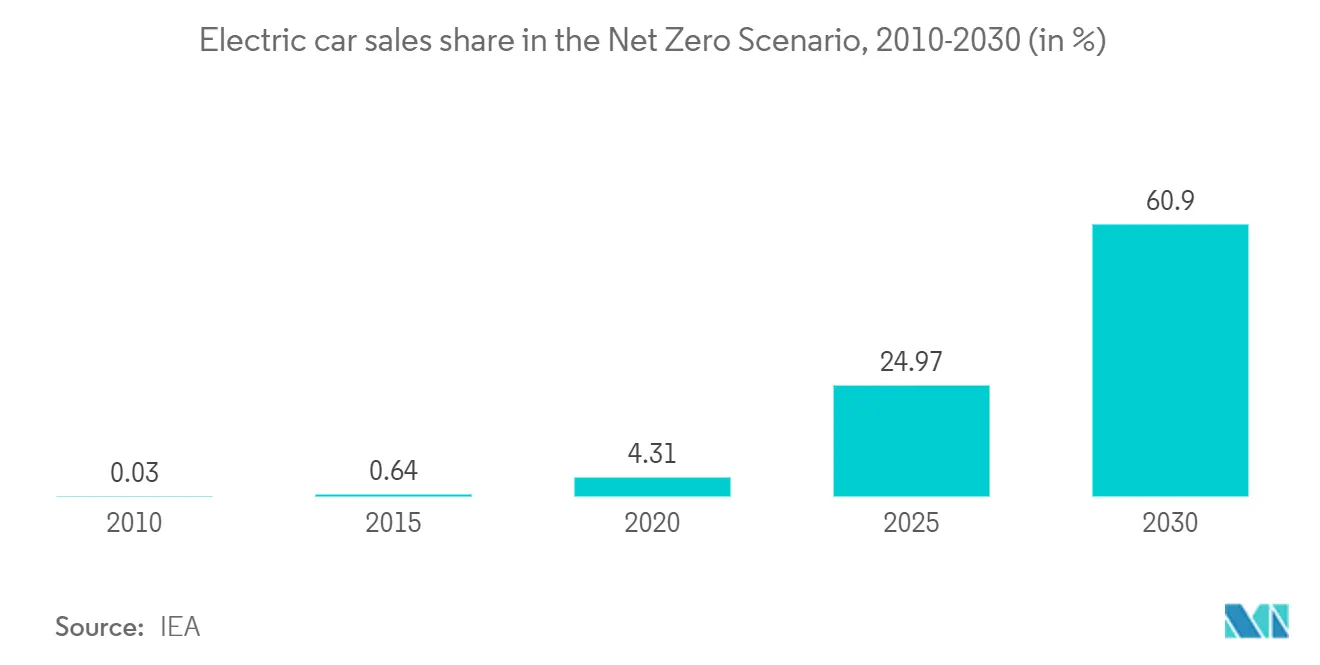
North America Expected to Hold a Significant Market Share
- North American region is anticipated to hold a significant share of the overall model-based enterprise market, primarily due to various major players in the area, including GE, PTC, Autodesk, and Aras, among others. These companies have adopted different growth strategies focusing on strengthening their market position.
- Moreover, institutes such as the Digital Manufacturing and Design Innovation Institute (DMDII) possess the ability, innovative spirit, and collaborative expertise that is being used to transform the American manufacturing sector by aiding organizations and helping in the digital revolution.
- Modern manufacturing facilities in the US have relied on newer technologies and innovations to produce high-quality products faster and at lower costs. Owing to the early adoption of these advanced technologies, such as IoT, big data, 3D modeling, DevOps, and mobility, manufacturers in the country have been integrating these advanced technologies to streamline their processes and use their deeper insights.
- The US is also one of the biggest automotive markets globally and is home to more than 13 major automotive manufacturers. Automotive manufacturing has been one of the largest revenue generators for the country in the manufacturing sector, further helping the market’s growth in the region.
- Canada is a major country taking significant steps toward implementing Industry 4.0 and is expected to contribute to the market growth during the forecast period.
- As stated by the Canadian government, the country aims to increase manufacturing sales by 50%, to reach USD 1 trillion by 2030, and exports by 50%, reaching USD 540 billion by 2030. This is expected to boost the manufacturing sector; therefore, the penetration of advanced automated technologies is set to boost market growth.
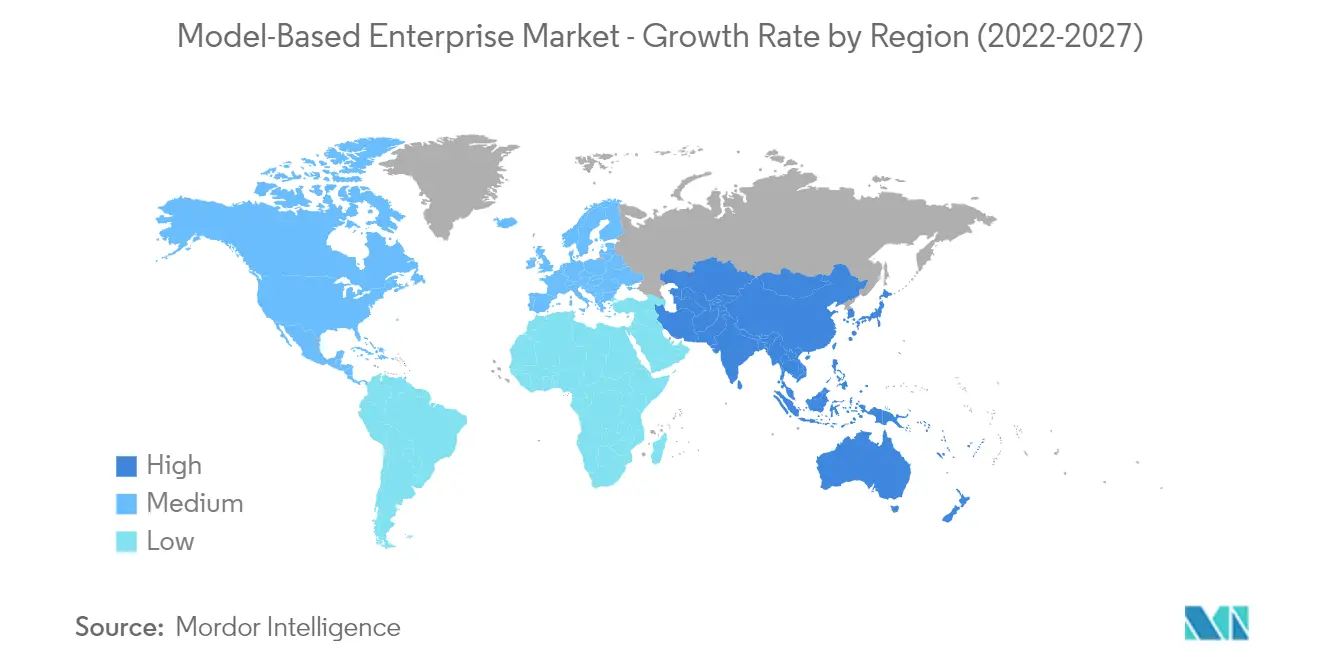
Model-based Enterprise Industry Overview
The model-based enterprise market is competitive owing to the presence of several large players operating in the domestic and international markets. The market appears to be moderately concentrated, with the major players in the market adopting strategies like product innovation, mergers, and acquisitions, and strategic partnerships primarily to enhance their product offerings, extend their geographical reach, and stay ahead of the competition. Some of the major players in the market are Siemens AG, Dassault Systèmes SE, SAP SE, and Autodesk Inc., among others.
- In February 2022, Siemens Digital Industries Software launched the latest release of its industry-leading NX software, part of the Xcelerator portfolio of software and services. The new NX Topology Optimizer helps create parts based purely on functional and design space requirements, resulting in fully editable convergent bodies that would be almost impossible to design and engineer manually.
- In November 2021, in Formnext 2021, GE Electric Company announced the Amp process management software platform. From mid-November 2021, the company also announced a limited release of print models, simulations, and corrections for the first two modules for the Concept Laser M2 machine. A broader release is planned for the second quarter of 2022.
- In November 2021, iBASEt, an Indian company, announced the launch of a Model-based Enterprise (MBE) offering that could accelerate a manufacturer's Industry 4.0 journey. Based on Solumina iSeries i050, the first version provides a way for manufacturers to start operating as a "Validated, Model-Centric" enterprise.
Model-based Enterprise Market Leaders
Siemens AG
Dassault Systèmes SE
SAP SE
Autodesk, Inc.
HCL Technologies Limited
*Disclaimer: Major Players sorted in no particular order
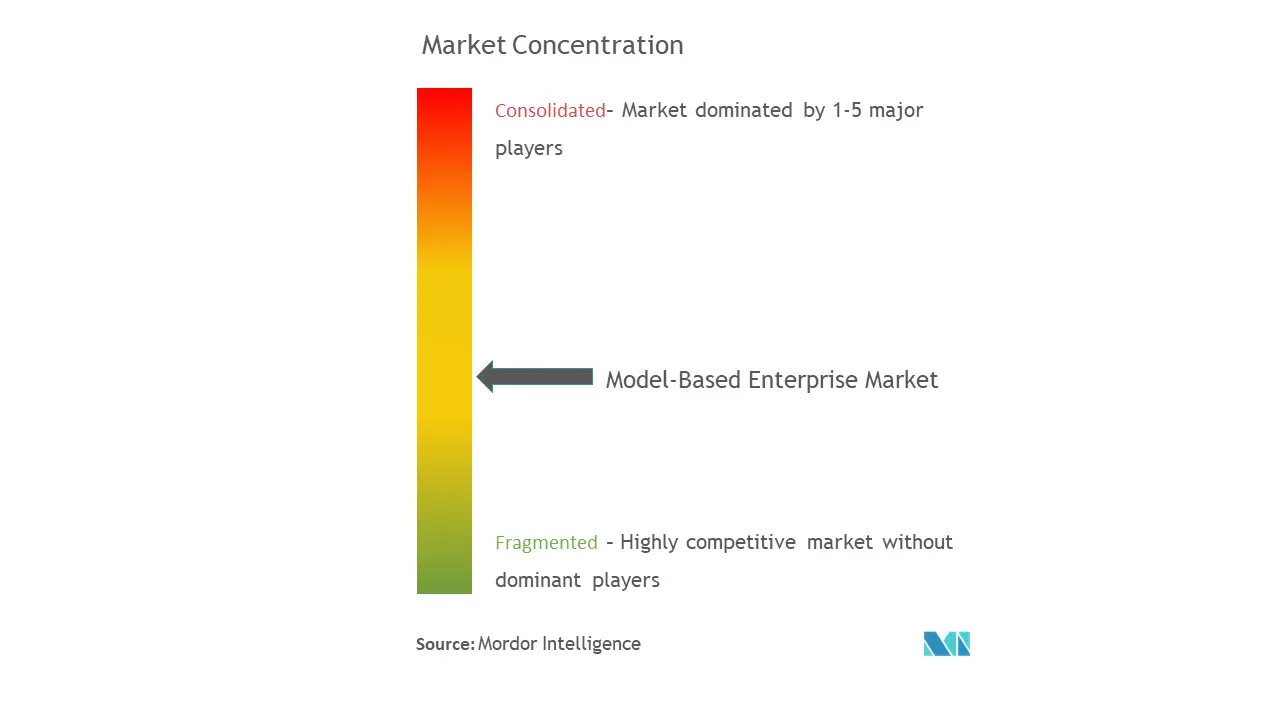
Model-based Enterprise Market News
- February 2022, Volkswagen Group’s Bentley Motors announced that it was doubling the additive manufacturing (AM) capacity at its factory in Crewe, England, which is responsible for assembling all Bentley models. Thanks to an investment of GBP 3 million into the technology, the luxury brand will be able to expand its ability to 3D print parts for various uses.
- February 2022, Ford released CAD files that enabled customers to 3D print models of their accessories for their Maverick pickup truck. Also, the files are for the pickup’s Ford Integrated Tether System (FITS), a series of slots at the rear of the center console, and the under-seat storage bins that can be customized with a wide variety of accessories, such as cup holders and phone mounts. Digital 3D model repository Thingiverse has uploaded numerous accessory designs that customers can download and print themselves, including cup holders, shopping bag hooks, phone holders, and more.
Model-based Enterprise Market Report - Table of Contents
1. INTRODUCTION
1.1 Study Assumptions and Market Definition
1.2 Scope of the Study
2. RESEARCH METHODOLOGY
3. EXECUTIVE SUMMARY
4. MARKET INSIGHTS
4.1 Market Overview
4.2 Industry Attractiveness - Porter's Five Force Analysis
4.2.1 Threat of New Entrants
4.2.2 Bargaining Power of Buyers
4.2.3 Bargaining Power of Suppliers
4.2.4 Threat of Substitute Products
4.2.5 Intensity of Competitive Rivalry
4.3 Assessment of the Impact of COVID-19 on the Market
5. MARKET DYNAMICS
5.1 Market Drivers
5.1.1 Evolving Software Capabilities
5.1.2 Rising Adoption of IoT and Cloud-based Platforms
5.2 Market Restraints
5.2.1 Slow Transition from On-premise to Cloud-based Platform
6. MARKET SEGMENTATION
6.1 By Offering
6.1.1 Solutions
6.1.2 Services
6.2 By Deployment Mode
6.2.1 On-premise
6.2.2 Cloud
6.3 By End User
6.3.1 Aerospace and Defense
6.3.2 Automotive
6.3.3 Construction
6.3.4 Power and Energy
6.3.5 Retail
6.3.6 Other End Users
6.4 By Geography
6.4.1 North America
6.4.2 Europe
6.4.3 Asia-Pacific
6.4.4 Latin America
6.4.5 Middle-East and Africa
7. COMPETITIVE LANDSCAPE
7.1 Company Profiles
7.1.1 Siemens AG
7.1.2 General Electric Company
7.1.3 PTC Inc.
7.1.4 Dassault Systèmes SE
7.1.5 SAP SE
7.1.6 Autodesk Inc.
7.1.7 HCL Technologies Limited
7.1.8 Oracle Corporation
7.1.9 Aras Corporation
7.1.10 Anark Corporation
- *List Not Exhaustive
8. INVESTMENT ANALYSIS
9. MARKET OPPORTUNITIES AND FUTURE TRENDS
Model-based Enterprise Industry Segmentation
Model-based enterprise (MBE) is an engineering strategy that primarily aims to clarify the design intent during the manufacturing process by using a 3D model-based definition that includes all the product and manufacturing process information associated with the manufacturing of the product. The primary aim of the MBE is to improve overall efficiency, produce better quality products, and reduce cost. One of the biggest advantages of MBE is that it replaces costly and inefficient paper-based systems.
The model-based enterprise market is segmented by offering (solution, services), deployment mode (on-premise, cloud), end user (aerospace & defense, automotive, construction, power & energy, retail, and other end users), and geography.
| By Offering | |
| Solutions | |
| Services |
| By Deployment Mode | |
| On-premise | |
| Cloud |
| By End User | |
| Aerospace and Defense | |
| Automotive | |
| Construction | |
| Power and Energy | |
| Retail | |
| Other End Users |
| By Geography | |
| North America | |
| Europe | |
| Asia-Pacific | |
| Latin America | |
| Middle-East and Africa |
Model-based Enterprise Market Research FAQs
How big is the Model-based Enterprise Market?
The Model-based Enterprise Market size is expected to reach USD 16.62 billion in 2023 and grow at a CAGR of 16.09% to reach USD 35.04 billion by 2028.
What is the current Model-based Enterprise Market size?
In 2023, the Model-based Enterprise Market size is expected to reach USD 16.62 billion.
Who are the key players in Model-based Enterprise Market?
Siemens AG, Dassault Systèmes SE, SAP SE, Autodesk, Inc. and HCL Technologies Limited are the major companies operating in the Model-based Enterprise Market.
Which is the fastest growing region in Model-based Enterprise Market?
Asia-Pacific is estimated to grow at the highest CAGR over the forecast period (2023-2028).
Which region has the biggest share in Model-based Enterprise Market?
In 2023, the North America accounts for the largest market share in the Model-based Enterprise Market.
Model-based Enterprise Industry Report
Statistics for the 2023 Model-based Enterprise market share, size and revenue growth rate, created by Mordor Intelligence™ Industry Reports. Model-based Enterprise analysis includes a market forecast outlook to 2028 and historical overview. Get a sample of this industry analysis as a free report PDF download.
